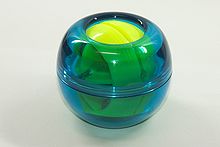Gyroscopic exercise tool

A gyroscopic exercise tool is a specialized device used in physical therapy to improve wrist strength and promote the development of palm, wrist, forearm, and finger muscles. It can also be used as a unique demonstration of some aspects of rotational dynamics. The device consists of a tennis ball-sized plastic or metal shell surrounding a free-spinning mass, with an inner heavy core, which can be spun by a short rip string. Once the gyroscope inside is going fast enough, the person holding the device can accelerate the spinning mass to high rotation rates by moving the wrist in a circular motion. The force enacted on the user increases as the speed of the inner gyroscope increases.
Mechanics
[edit]This article's tone or style may not reflect the encyclopedic tone used on Wikipedia. (March 2024) |
Inside the outer shell, the spinning mass is fixed to a thin metal axle, with each end trapped in a circular, equatorial groove in the outer shell. A lightweight ring with two notches for the axle ends rests in the groove, allowing the ball to spin perpendicular to the rotational axis of the ring.
To increase the angular velocity of the ball, the sides of the groove exert forces on the ends of the axle. While normal and axial forces have no effect, the tangential force is provided by the friction of the ring acting on the axle. The user can apply a torque on the ball by tilting the shell in any direction except in the plane of the groove or around an axis aligned with the axle. This tilting results in a shift of the axle ends along the groove. The direction and speed of this shift can be determined using the formula for the precession of a gyroscope: the applied torque is equal to the cross product of the angular velocity of precession and the angular momentum of the spinning mass. The rate of rotation of the internal ball increases as the total applied torque increases. The direction of the torque does not matter, as long as it is perpendicular to the plane of rotation of the ball. The friction of the ring increases on the side opposite to the plane of rotation. This process is symmetric across the plane perpendicular to the axle. The only restriction is that the relative speed of the surface of the axle and the side of the groove due to precession (ΩPRgroove) must exceed the relative speed due to the rotation of the spinning mass (ωraxle). The minimum torque required to meet this condition is Iω2(Rgrooveraxle), where I is the moment of inertia of the spinning mass, and ω is its angular velocity.
Angular acceleration occurs regardless of the direction of the applied torque, as long as it is sufficient. The device functions without fine-tuning the driving motion, and the tilting of the shell does not need to be in rhythm with the precession or at the same frequency. Since kinetic friction is almost as strong as static friction for the materials typically used, it is not necessary to apply exactly the amount of torque needed for the axle to roll without slipping along the side of the groove. These factors enable beginners to learn to speed up the rotation within a few minutes of practice.
Using the proportionality of the kinetic force of friction to the normal force, fk=μkFn, where μk is the kinetic coefficient of friction, it can be shown that the torque spinning up the mass is a factor of μk(Rgrooveraxle) smaller than the torque applied to the shell. Since frictional force is essential for the device's operation, the groove must not be lubricated to ensure that the friction of the ring can enact a force on the gyro.
